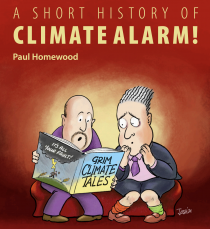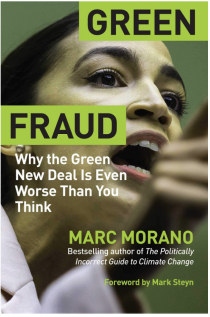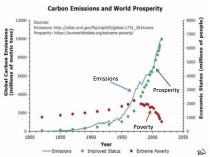JUST IN

See the history by Paul Homewood here
Marc Morano’s ’Green Fraud‘ blockbuster book is also a must read.

AOC’s chief of staff Saikat Chakrabarti revealed that the Green New Deal was not about climate change. The Washington Post reported Chakrabarti’s unexpected disclosure in 2019. “The interesting thing about the Green New Deal,” he said, “is it wasn’t originally a climate thing at all.” He added, “Do you guys think of it as a climate thing? Because we really think of it as a how-do-you-change-the-entire economy thing. “Former Ocasio-Cortez campaign aide Waleed Shahid admitted that Ocasio-Cortez’s GND was a “proposal to redistribute wealth and power from the people on top to the people on the bottom.”
---------
This echoed IPCC official Ottmar Edenhofer who in November 2010 admitted “one has to free oneself from the illusion that international climate policy is environmental policy.” Instead, climate change policy is about how “we redistribute de facto the world’s wealth.” UN Climate Chief Christiana Figueres said “Our aim is not to save the world from ecological calamity but to change the global economic system (destroy capitalism).”
The evidence about the fraud is mounting but don’t expect coverage in the media. A must see A CLIMATE AND ENERGY PRIMER FOR POLITICIANS AND MEDIA by contributing author Allan MacRae Allan is a highly respected energy leader in Canada who has worked with true climate experts and has helped make Alberta the shining star of Canadian energy over the decades. There too the politicians and media and the public have been programmed by false claims and green energy frauds and are willing to toss the low cost clean fossil fuel energy legacy out and replace it with unreliable and expensive green energy.
Greens expect population to adapt its consumption to the available supply and simply come to accept rationing and power interruptions, of the sort that are unfortunately still common in underdeveloped countries. They insist that is the necessary price for averting the phoney climate apocalypse.
See also Stephen Moores’ Follow the Climate Change Money here. This is something Eisenhower warned about in his Farewell address:
“The prospect of domination of the nation’s scholars by Federal employment, project allocations, and the power of money is ever present - and is gravely to be regarded.”
----------
COLLEGE OF ENGINEERING, CARNEGIE MELLON UNIVERSITY
For decades, climate change researchers and activists have used dramatic forecasts to attempt to influence public perception of the problem and as a call to action on climate change. These forecasts have frequently been for events that might be called “apocalyptic,” because they predict cataclysmic events resulting from climate change.
In a new paper published in the International Journal of Global Warming, Carnegie Mellon University’s David Rode and Paul Fischbeck argue that making such forecasts can be counterproductive. “Truly apocalyptic forecasts can only ever be observed in their failure--that is the world did not end as predicted,” says Rode, adjunct research faculty with the Carnegie Mellon Electricity Industry Center, “and observing a string of repeated apocalyptic forecast failures can undermine the public’s trust in the underlying science.”
Rode and Fischbeck, professor of Social & Decision Sciences and Engineering & Public Policy, collected 79 predictions of climate-caused apocalypse going back to the first Earth Day in 1970. With the passage of time, many of these forecasts have since expired; the dates have come and gone uneventfully. In fact, 48 (61%) of the predictions have already expired as of the end of 2020.
Fischbeck noted, “from a forecasting perspective, the ‘problem’ is not only that all of the expired forecasts were wrong, but also that so many of them never admitted to any uncertainty about the date. About 43% of the forecasts in our dataset made no mention of uncertainty.”
In some cases, the forecasters were both explicit and certain. For example, Stanford University biologist Paul Ehrlich and British environmental activist Prince Charles are serial failed forecasters, repeatedly expressing high degrees of certainty about apocalyptic climate events.
Rode commented “Ehrlich has made predictions of environmental collapse going back to 1970 that he has described as having ‘near certainty’. Prince Charles has similarly warned repeatedly of ‘irretrievable ecosystem collapse’ if actions were not taken, and when expired, repeated the prediction with a new definitive end date. Their predictions have repeatedly been apocalyptic and highly certain...and so far, they’ve also been wrong.”
The researchers noted that the average time horizon before a climate apocalypse for the 11 predictions made prior to 2000 was 22 years, while for the 68 predictions made after 2000, the average time horizon was 21 years. Despite the passage of time, little has changed--across a half a century of forecasts; the apocalypse is always about 20 years out.
Fischbeck continued, “It’s like the boy who repeatedly cried wolf. If I observe many successive forecast failures, I may be unwilling to take future forecasts seriously.
That’s a problem for climate science, say Rode and Fischbeck.
“The underlying science of climate change has many solid results,” says Fischbeck, “the problem is often the leap in connecting the prediction of climate events to the prediction of the consequences of those events.” Human efforts at adaptation and mitigation, together with the complexity of socio-physical systems, means that the prediction of sea level rise, for example, may not necessarily lead to apocalyptic flooding.
“By linking the climate event and the potential consequence for dramatic effect,” noted Rode, a failure to observe the consequence may unfairly call into question the legitimacy of the science behind the climate event.”
With the new Biden administration making climate change policy a top priority, trust in scientific predictions about climate change is more crucial than ever, however scientists will have to be wary in qualifying their predictions. In measuring the proliferation the forecasts through search results, the authors found that forecasts that did not mention uncertainty in their apocalyptic date tended to be more visible (i.e., have more search results available). Making sensational predictions of the doom of humanity, while scientifically dubious, has still proven tempting for those wishing to grab headlines.
The trouble with this is that scientists, due to their training, tend to make more cautious statements and more often include references to uncertainty. Rode and Fischbeck found that while 81% of the forecasts made by scientists referenced uncertainty, less than half of the forecasts made by non-scientists did.
“This is not surprising,” said Rode, “but it is troubling when you consider that forecasts that reference uncertainty are less visible on the web. This results in the most visible voices often being the least qualified.”
Rode and Fischbeck argue that scientists must take extraordinary caution in communicating events of great consequence. When it comes to climate change, the authors advise “thinking small.” That is, focusing on making predictions that are less grandiose and shorter in term. “If you want people to believe big predictions, you first need to convince them that you can make little predictions,” says Rode.
Fischbeck added, “We need forecasts of a greater variety of climate variables, we need them made on a regular basis, and we need expert assessments of their uncertainties so people can better calibrate themselves to the accuracy of the forecaster.”
----------------
Note: Mark Perry on Carpe Diem here listed 18 major failures.
Here he worked with CEI to compile 50 predictions of catastrophes that failed here.
“Most of the people who are going to die in the greatest cataclysm in the history of man have already been born,” wrote Paul Ehrlich in a 1969 essay titled “Eco-Catastrophe! “By...[1975] some experts feel that food shortages will have escalated the present level of world hunger and starvation into famines of unbelievable proportions. Other experts, more optimistic, think the ultimate food-population collision will not occur until the decade of the 1980s.”
Erlich sketched out his most alarmist scenario for the 1970 Earth Day issue of The Progressive, assuring readers that between 1980 and 1989, some 4 billion people, including 65 million Americans, would perish in the “Great Die-Off.”
“It is already too late to avoid mass starvation,” declared Denis Hayes, the chief organizer for Earth Day, in the Spring 1970 issue of The Living Wilderness.
Leonard Nimoy talked about the coming ice age in 1979 here.
Tony Heller exposes the fraudsters here:





